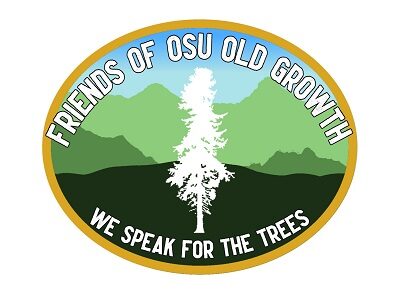Please comment on OSU’s Draft Plan
(Deadline: July 18th, 2025)
For a list of shortcomings of OSU’s draft plan, see:
Shortcomings of OSU’s Draft Management Plan for the McDonald-Dunn Forest
You can find the (171-page) draft plan and submit comments on OSU’s webpage for the McDonald-Dunn Forests:
(https://cf.forestry.oregonstate.edu/our-forests/mcdonald-dunn-forest-plan-draft)
Alternatively, you can email comments and supporting information to:
McDonaldDunnPlan@oregonstate.edu
Please share your comments with the OSU President and Trustees by including them in the “To” field of your message: trustees@oregonstate.edu
Follow the Money: For those of you who are unfamiliar with how timber industry funding corrupts Oregon State University’s College of Forestry and the “research forests”, here are the basic facts:
- The College of Forestry dean is paid from a $5M fund established by the former CEO and heir to the Roseburg Forest Products empire.
- Timber industry donors have given substantial sums of money and land to OSU over the years (totaling hundreds of millions of dollars in value), giving them great influence over university leaders*.
- OSU has received substantial public/tax funding through the years. The College of Forestry has benefitted from the Forest Products Harvest Tax (established in 1947), with total payments perhaps exceeding $100M.
- OSU pays NO property tax on research forest lands (as they are state-owned). This has provided the College of Forestry with a substantial, long-term, public subsidy.
- Research Forest staff are paid from logging revenue (so they are incentivized to perpetuate logging in these public forests).
- Very little logging revenue (typically less than 2%) supports research and recreation.
- Logging revenue is routinely used to cover cost overruns and projects unrelated to the forests.
- Between 2014 and 2023, logging revenue from the OSU research forests totaled nearly $55M (with ~70% going toward expenses, which includes payments to logging contractors).
- Over this same period (2014-2023), the net revenue to OSU was ~$18M (or $1.8M/year).
It is vital that the general public understand these basic financial details because they are the underpinnings of OSU’s current draft management plan for the McDonald-Dunn Forests.
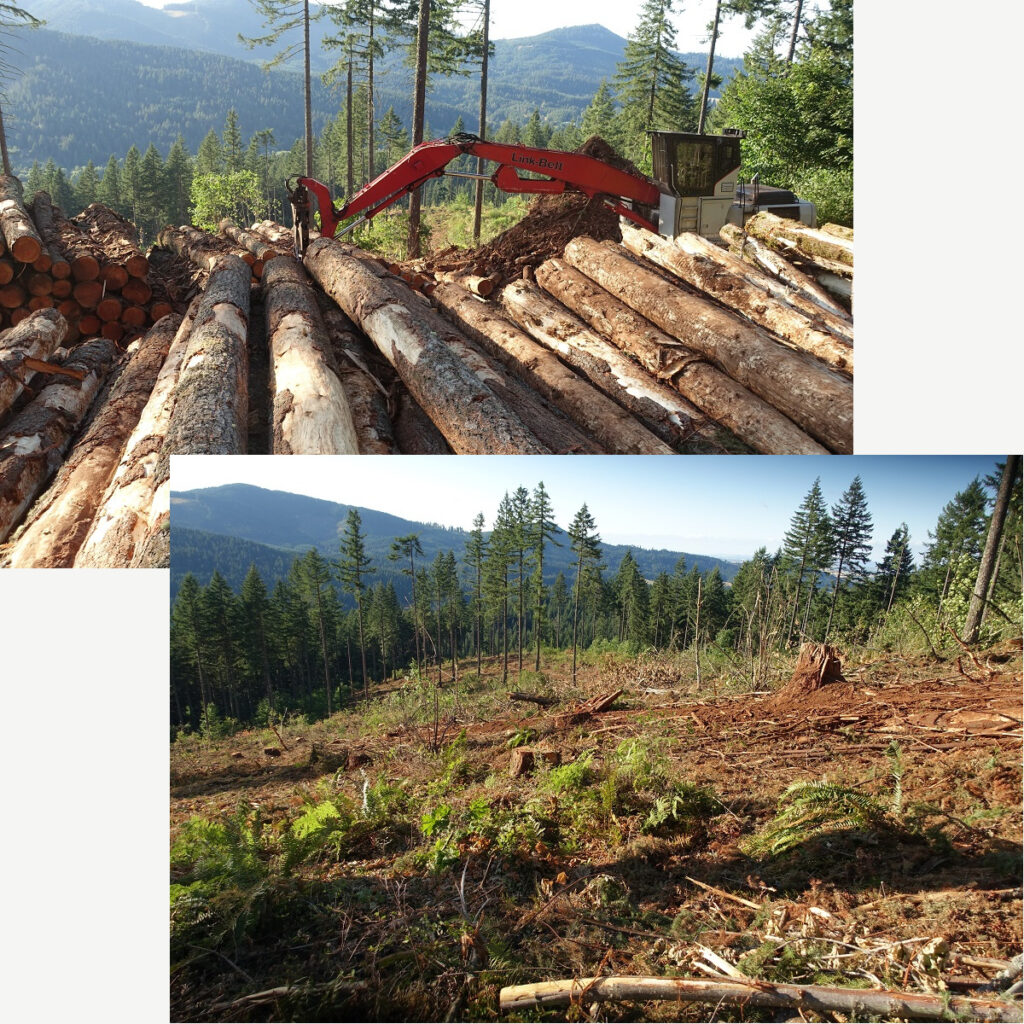
Logging revenue pays the salaries of OSU’s forest managers, perpetuating a system that is rife with conflicts of interest. College leaders have relied on this revenue to cover cost overruns and fund a wide range of projects. The result is a system that prioritizes timber harvests far beyond other values, such as ecological research, wildlife habitat, and protecting older forest stands. (photo from OSU’s Davie Crockett 2 cut, June 2021)
The dean of the College is paid from a $5M endowment provided by the heir to (and former CEO of) Roseburg Forest Products, Oregon’s fifth largest private company and one of the nation’s largest family-held timber companies. OSU shamelessly promotes this privatizing of our public university by formally listing the dean as the, “Cheryl Ramberg-Ford and Allyn C. Ford Dean of the College of Forestry“1https://www.fororegonstate.org/stay-informed/impact-stories/detail/cheryl-ramberg-ford-and-allyn-c-ford-dean-of-the-college-of-forestry.
The dean’s title speaks volumes about his allegiances. He is not so much a public official, as a proxy for his industry sponsors. We saw this in spades with the Elliott State Research Forest process, where the dean promoted his antiquated, “working forests research model” that was soundly rejected by some of the College’s most venerable experts. They described OSU’s plan as, “the cart leading the horse“, and lacking in basic scientific relevance and rigor. With Roseburg Forest Products benefitting from logging in the Elliott, the direct involvement of their dean in the Elliott process constituted a considerable conflict of interest. The public overwhelmingly rejected OSU’s timber-centric research plan, which was likely a major factor in OSU leaders deciding to withdraw from the Elliott process in November 2023.
The Origins of the “Research Forests”: For roughly a century, OSU has acquired and managed a portfolio of forested lands which it began referring to as, “research forests” in the early 80’s. Some of the forested lands were donated, while others have been purchased through a mix of private donations and public funding. The Dunn Forest, located near Corvallis, consists largely of lands acquired through condemnation proceedings by the federal government to support the training of troops during WWII. This land was transferred to OSU (free of charge) with certain stipulations. It had to serve as a “teaching laboratory”, with mature timber, “harvested in accordance with sound forestry practices and the proceeds used for research purposes”. Similarly, the McDonald Forest lands were donated with the intent that they be used to educate young people about agriculture and forestry.2https://cf.forestry.oregonstate.edu/our-forests/mcdonald-history
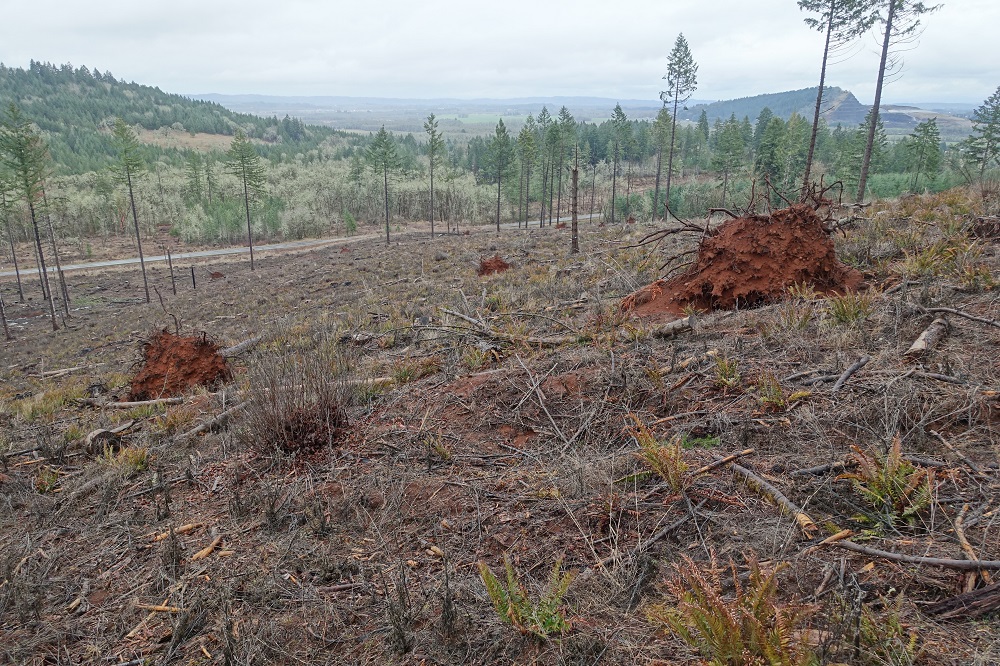
Large sections of older forest in the Dunn have been liquidated under OSU’s management. How does this align with the original intent of the public land transfer (for a “teaching laboratory…the proceeds used for research purposes“)?
In practice, OSU has routinely ignored the intent of the original donors to suit its changing priorities and fiscal needs. In 1992, the Richardson family donated 1,400 acres of forestland with the intent it be stewarded by the College of Forestry. The subsequent sale of the property (for $23.8M) made it the largest donation in OSU’s history.3 While the college’s forestry magazine praised the gift, OSU sources told me the sale of the property was highly controversial because it violated the long-standing intent of the donor.
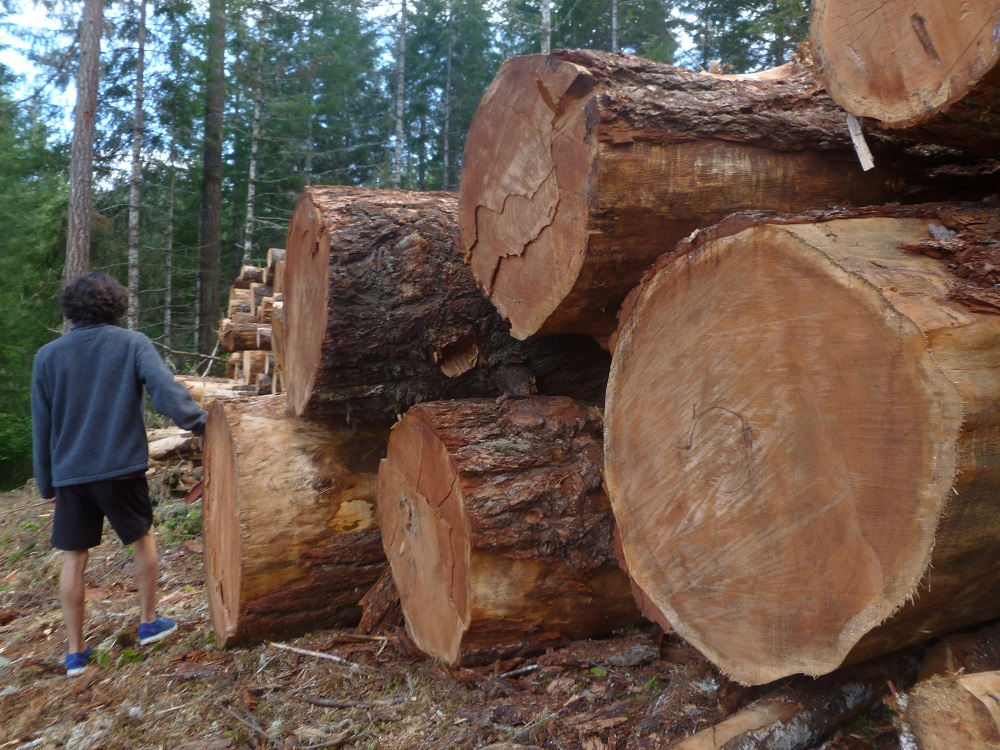
In May of 2019, OSU’s forest managers oversaw the cutting of ~16 acres of ancient forest near Corvallis. At first they claimed they absolutely did NOT cut old growth, directly contradicting OSU’s own forest data. They later tried to justify the cutting by claiming there were “signs of mortality in the stand” and the trees presented a public safety hazard. OSU’s internal documents revealed it made ~$460,000 from the harvest, roughly 1/3 of the annual budget for the McDonald-Dunn.
Monetizing Our Public Forests: A significant portion of the OSU forests has been “harvested” (mostly clearcut) over the past century – not for research purposes, but to pay the salaries of forest staff and fund various projects within the College of Forestry. Between 2014 and 2023, Oregon State University’s Research Forests (including the McDonald-Dunn) generated approximately $54.8 million in gross revenue from logging activities3https://friendsofosuoldgrowth.org/wp-content/uploads/2024/07/Revenue-and-Expenses-COF-Forests-071224.pdf. This included $6M in accelerated clearcutting in the Blodgett Research Forest (located near Clatskanie) to pay for cost overruns associated with OSU’s newest forestry buildings.4‘Majestic’ Douglas fir stood for 420 years. Then Oregon State University foresters cut it down, Jul. 26, 2019, by Rob Davis, https://www.oregonlive.com/environment/2019/07/majestic-douglas-fir-stood-for-420-years-then-oregon-state-university-foresters-cut-it-down.html
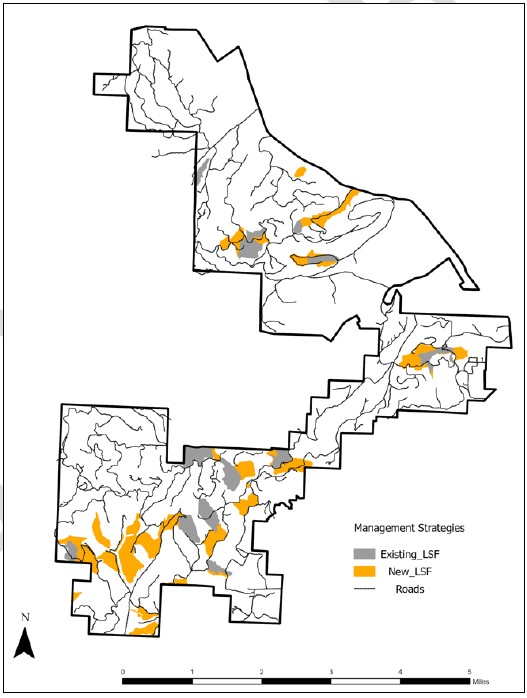
This poorly designed map in the draft plan is the first information OSU has provided showing their proposed, “late-successional forest” classification. Note the absence of buffers surrounding the existing old-growth stands (shown in grey). The lack of any distinguishing features (such as roads or other landmarks) makes this map of little use and reflects poorly on the planning team’s capabilities. After years of development, this is the only graphical information they’ve provided to the general public concerning the classification of older forests.
A Fragmented Approach to Forest Planning: OSU’s draft plan is the opposite of a holistic or ecologically-focused stewardship plan. Watershed boundaries are ignored when it comes to determining land allocations (the word “watershed” appears only twice in the body of the 171-page report). The newly-created, “late-successional forest” classification fails to provide any meaningful or logical buffers surrounding older forest stands. The entire forest will now be managed as a mosaic of classifications that seems designed to ignore prevailing natural boundaries. This is a distinct departure from the 2005 plan, which provided distinct protections to substantial portions of the popular McDonald Forest.
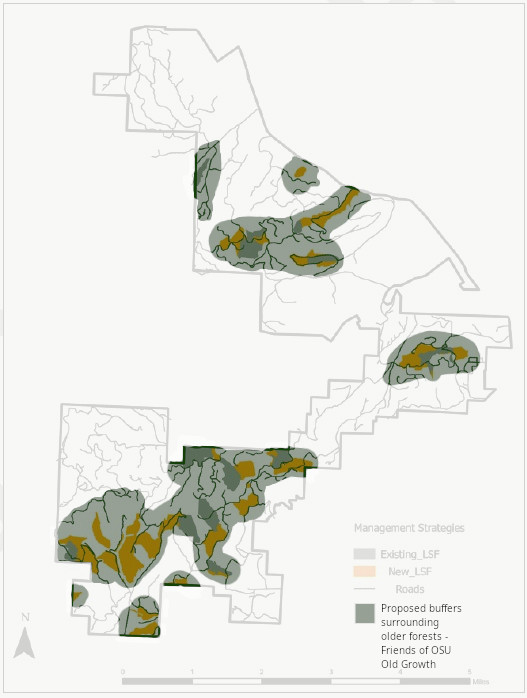
The OSU draft plan should have provided substantial protective buffers around older forest stands. This would have reflected natural watershed and ecological boundares, while honoring community values. It would also have provided abundant educational and research opportunities. (edited map courtesy of Friends of OSU Old Growth)
College Leaders Routinely Ignore Their Own Forest Plans: The rampant liquidation of these public forests has often occurred in direct violation of OSU’s management plans. In addition to the controversial destruction of old growth in 2019, OSU’s forest managers oversaw a dozen separate clearcuts which destroyed ~166 acres of older stands comprising habitat for northern spotted owls6. The 2005 Plan had promised to protect these stands. The $6M liquidation of the Blodgett Forest also violated the existing management plan.
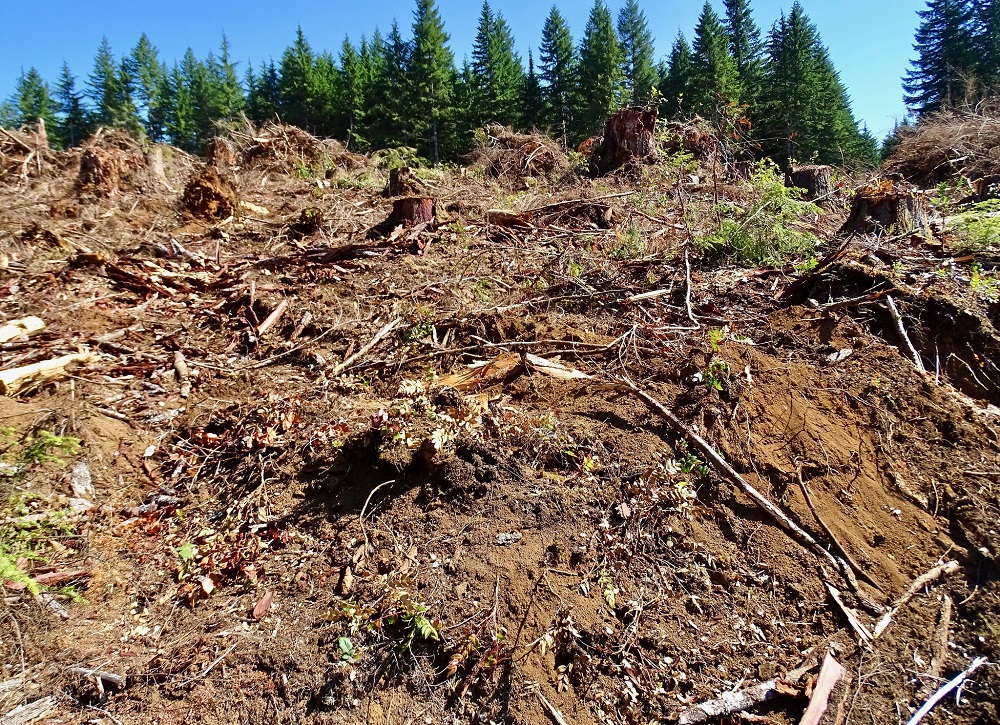
OSU violated its widely acclaimed management plan for the Blodgett Research Forest when it cut $6M in timber to pay for cost overruns associated with its newest forestry buildings in Corvallis. (Newton Clear harvest, 2019, photo by Francis Eatherington)
“We make plans and then immediately violate them!”: The Blodgett Forest, located near Clatskanie, Oregon, was donated to the Oregon State College of Forestry in 1929 by John W. Blodgett (the owner of a timber company), “With the thought in mind of aiding and expediting the gathering and correlating of data necessary to the formulation of a sound reforestation program for Western Oregon.“5OSU’s 1999 Blodgett Forest Plan, College leaders subsequently neglected the forest, and Mr. Blodgett was so upset he advocated for turning the land over to the State Department of Forestry.
Research opportunities in the Blodgett took a backseat to logging until an interdisciplinary OSU team developed an acclaimed management plan for the forest in 1999. According to OSU sources, the plan was widely cited and highly regarded for its progressive approach to managing a research forest.
Two decades later, College leaders jettisoned the plan and liquidated a substantial portion of the forest to cover cost overruns associated with construction of the Oregon Forest Science Complex. The dean had even considered selling the Blodgett in its entirety. Minutes from OSU’s Forest Executive Committee reveal a deep divide among College leaders, with attendees acutely worried about the optics of either liquidating or selling the forest:
“…teaching, research, public interface, and extension were the primary reasons to own a College Forest…I’m not sure what it is says to Extension agents who are out there talking to small woodlands owners about sustainable practices…does the Macdonald-Dunn then become our industrial tract to generate revenues?
We make plans and then immediately violate them. The plan is there for a reason, especially to avoid cut and run…We ignore plans…Optimizing for profit is not what we’ve ever espoused…We should be embarrassed that we are the #1 COF in the nation and we don’t have a plan that is certified.
When is the last time someone gave their life gift to [a large timber company]? Never. It will impact our ability to garner future gifts if we sell the property…We are all short-termers in comparison to the land and forests…there may be future research opportunities in 30 years we would want that property for, and we’ll likely never get anything like that site again.
This has to do with our principles…It comes to bigger picture of what do we stand for, what do we teach? Our plan or lack thereof is embarrassing as we noted earlier. It looks like when faced with a financial bind, we just cash in. That’s the way to do business – that’s the signal we are sending with our action. Our reputation related to industry has gotten in the way with ecological and social research work in the past. We will undermine what we really stand for if this is what we do.”
OSU’s mismanagement of the Blodgett Forest has profound lessons for the McDonald-Dunn planning team and College leaders – if only they were open to learning them!
Scant funding of Research & Recreation: In practice, very little of the McDonald-Dunn logging revenue goes to support either research or recreation (contrary to OSU’s narrative). A public records request in 2020 revealed that only 1.6% of logging revenue supported research, while 1.2% went toward recreation in these public forests. OSU’s data clearly shows that much of the logging revenue goes to timber industry contractors and the staff who perpetuate logging the forests.
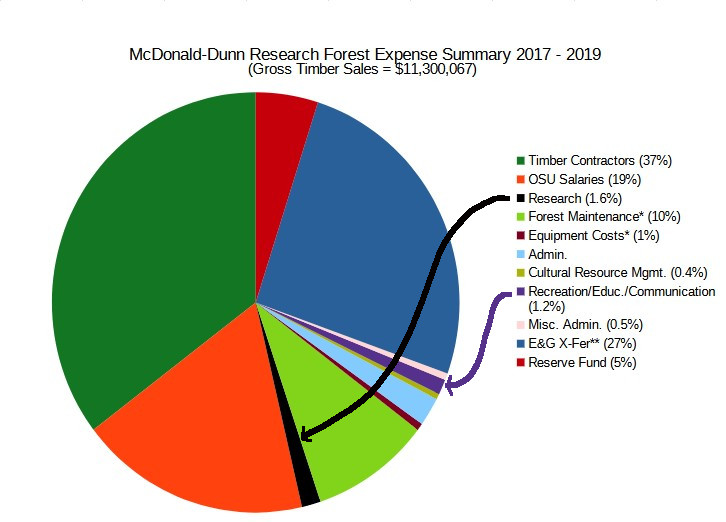
A public records request revealed that very little logging revenue supports research and education in the McDonald-Dunn (information courtesy of Steve Cook)
“Vision, Mission & Goals” Designed to Perpetuate Logging: The draft plan justifies OSU’s timber-centric approach to managing the McDonald-Dunn by pointing to the “Vision, Mission, and Goals” document covering all of the OSU research forests. This is rather deceptive, since this key document was developed by a committee within the College of Forestry, without any public notice or engagement. The committee and its predecessor (started by dean Thomas Maness around 2018) were given the mandate that the operation of the research forests must be self-funding (i.e. paid for by logging revenue). This was clearly a strategic decision designed to perpetuate industrial forestry practices across all of the university’s research forests.
Alternative Funding Models Ignored: Rather than using a portion of the Forest Products Harvest Tax, seeking funding from the state, or building an endowment to support the educational and research missions of the forests, College leaders have chosen to promote an outdated, “working forests research model” in these pubic forests.6Per State law (ORS 352.025 (2) (c)), the titles for all “real property” (which includes the McDonald-Dunn Research Forests) are held by the State of Oregon (not OSU or the College of Forestry). This, and the fact that OSU is a public university, clearly equates to public ownership of these forests (despite the dean’s frequent claims to the contrary). Since the public soundly rejected OSU’s “working forests” model in the Elliott, one wonders why OSU’s Faculty Planning Committee (FPC) decided it is appropriate for the McDonald-Dunn.
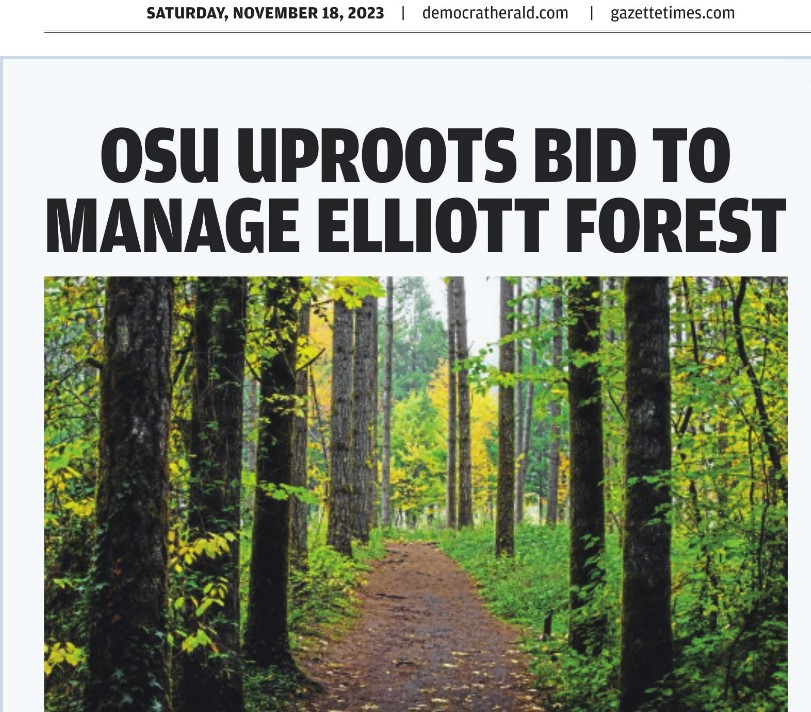
The president of OSU pulled the plug on the College of Forestry’s plans to manage the Elliott State Research Forest in 2023. The dean and his planning team are now promoting the same kind of “working forests research plan” for the McDonald-Dunn that the public overwhelmingly rejected for the Elliott.
“Woodstock” Model Biased Toward Timber Production: The draft plan explains that OSU’s Faculty Planning Committee utilized the “Woodstock” model to “develop a final suite of three scenarios to submit to the dean…for his consideration“. There’s no mention of the severe technical flaws and constraints of the model (which were pointed out in previous public meetings). The Woodstock model is widely criticized by forestry experts for its traditional bias toward wood fiber production over ecological values. It was originally designed to maximize timber harvest volumes and economic returns using simplistic, linear programming algorithms. By choosing this biased software as the central engine of their forest modeling, the OSU team has doomed the results to rejection by both academics and informed citizens alike.
Three Alternatives that are Nearly the Same – and a Predictable Outcome: As the chart from the draft plan below shows, there is remarkably little difference between the land allocations in the three scenarios. The amount of “even-aged, short rotation” (conventional, clearcut forestry), “Late-successional forest” (old growth), “Ecosystems of concern”, and “Long term learning” is the EXACT SAME in each scenario! The only differences concern the amount of forest split between “even-aged, long rotation”, and “Multi-aged, multi-species” forest. In short the scenarios seem designed to give the illusion of choice where very little exists! The lack of variability in management options gives the strong impression that the outcome was predetermined by OSU leaders (not the FPC).


This table is from Appendix G of the McDonald-Forest draft plan
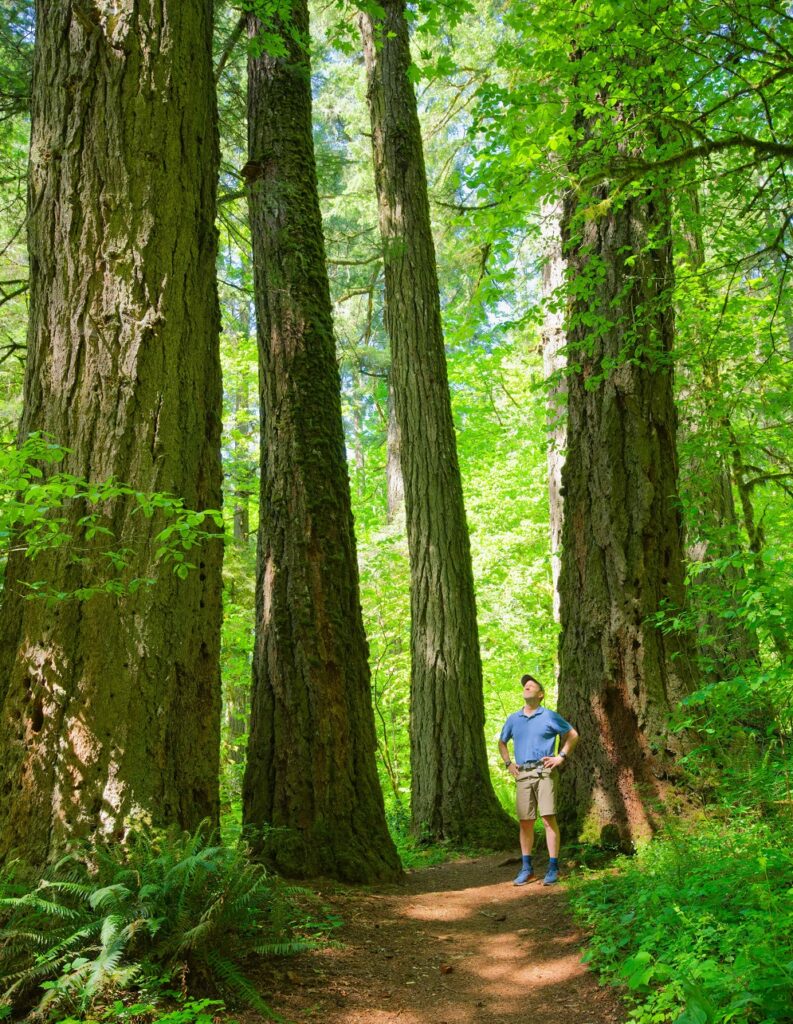
Citizens have overwhelmingly insisted OSU protect substantially more older forest, yet OSU’s draft plan only allocates 10% of the McDonald-Dunn as “late-successional forests”. It is disingenuous of OSU’s forest planners to insist they have honored public input. (OSU’s Old Growth Trail, photo Trygve Steen)
Draft Plan Ignores Public Input Seeking Forest Protections: Citizens have overwhelmingly rejected OSU’s timber-centric management approach and repeatedly asked that large areas of the McDonald-Dunn be protected from logging. It is deceitful for OSU’s planning committee to insist they are, “taking into account feedback received from the Stakeholder Advisory Committee and the community” in selecting the three management scenarios presented to the dean (when all three scenarios only set aside 10% of the forests from logging)!

Conflicts of Interest Plague OSU’s Forest Planning Process: It should come as no surprise that the draft management plan includes only a modest increase in protecting older forest and NO variability in four of the six management scenarios. This is the predictable result of having a dean and college that are largely funded by timber industry money – and when the people writing the forest plan are paid from logging revenue.
The draft plan lists four research forest employees as contributors. This includes the former director of the research forests, Stephen Fitzgerald, who served as, “Forest Plan Development Co-Chair”. Fitzgerald was the director of the OSU forests in 2019, when 16 acres of old-growth forest was deliberately cut, in violation of OSU’s 2005 Forest Plan. Long after the interim dean declared that cutting the ancient forest was a mistake and did not reflect the values of the college, Fitzgerald sought to justify it. According to multiple sources, he insisted it was consistent with the 2005 plan and his only mistake was not anticipating public sentiment. His claims were refuted in a 21-page report authored by OSU experts who showed the cutting clearly violated OSU’s forest plan.
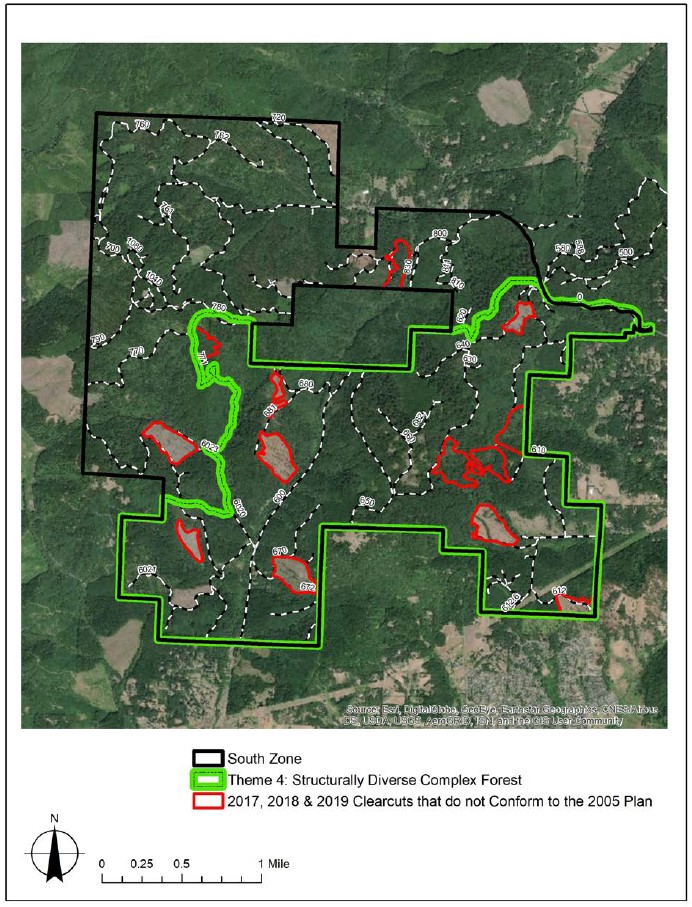
A comprehensive analysis by OSU experts identified at least a dozen clearcuts in the McDonald Forest that violated the 2005 Plan (from “Damage to Ecological Resources on the OSU McDonald-Dunn Forest“)
Critics also point to Fitzgerald’s involvement in the OSU’s “Biscuit Fire Publication Controversy” as proof of his bias in favor of the timber industry. Fitzgerald was the subject of a comprehensive ethics complaint in 2020 for his efforts to conceal information related to a previous planning committee. With his long history of ideological bias, Fitzgerald’s primary involvement in OSU’s forest planning process undermined the integrity of the planning process and compromised the draft plan.
Furthermore, the substantial involvement of three research forest staff members in the planning process (including the associate director of operations, Brent Klumph, and the inventory, GIS, and reforestation manager, Carli Morgan) raises serious questions about objectivity. With all of these folks depending on continued logging revenue for their salaries, their involvement in the planning process clearly violates OSU’s Policy on Financial Conflicts of Interest. The OSU policy states,
“A conflict of interest arises when an individual’s external interest(s) may, or could appear to, bias or unduly influence their decision-making during university work, or compromise their ability to fulfill their obligations to the university…
Individuals should not accept benefits, remuneration, gifts, loans, or otherwise engage with an entity, if circumstances would reasonably infer that those benefit(s) could unduly influence or reward decisions that they could make during university work.“[emphasis added]
Given the circumstances, one would “reasonably infer” that the salaries of research forest employees might, “unduly influence or reward decisions that they could make” as part of the forest planning process (which could have a direct impact on their future employment).
I raised these concerns with the dean, OSU President and Trustees in emails, but none of them were willing to respond.
OSU Promotes Draft Plan Despite History of Community Opposition: A recent OSU press release promotes the McDonald-Dunn planning process and draft plan with glowing terms such as: “carefully and thoughtfully produced stewardship plan“, “written with flexibility to enable new approaches“, “decisions will be made with the intention of promoting long-term resilience, and recognizing that climatic conditions are changing“, “process included public input sessions and collaboration among the college, its faculty, community members Tribal representative and multiple organizational partners“, “plan addresses climate change, shifting needs for wood products and the growing importance of resilient landscapes“.
This rosy portrayal stands in stark contrast to the scathing criticism OSU received during their community input sessions for the plan. As I reported in previous blog pieces (“Another Steaming Pile of Forest Planning Ire for the Dean and his Team“, and “OSU Feels the Heat of Forest Planning Ire“), OSU’s planning efforts to date have been strongly condemned by community members and even their own experts. Their choice of management scenarios and the underlying modeling were exposed as fundamentally deficient and illogical. Rather than embracing the criticism and changing course, it is clear that OSU’s planning team has dug in its heels. This diminishes public trust in the planning process, while raising questions about the integrity and judgement of the planning team members.
Biased Information Reveals Underlying Agenda: The draft plan offers a number of clues to what’s really going on behind the scenes of OSU’s forest planning. Under Section 3.6 “Threats to Forest Health”, the subject of climate change is addressed in a manner that is both exceptionally arrogant and aligned with timber-industry propaganda. The plan states:
“Threats such as climate change…will be actively managed and mitigated as appropriate.”
This defiant tone pretty much sums up OSU’s approach to forest management. Forests are not complex, living, ecosystems, but rather “resources to be managed”. Climate change is not so much a threat to the future of our planet and humanity, but simply something to be, “actively managed and mitigated”. One wonders how these so-called experts can be so lacking in humility.
Rather than considering the enormous capacity of our region’s older coniferous forests to sequester carbon, the OSU plan focuses on “mitigation” and “adaptation”. The plan describes “mitigation” by focusing on using forest products to store carbon and burning forest biomass to “provide renewable energy”. Both of these options are deeply problematic from a life-cycle perspective.
It is well established that only a small percentage of the overall forest carbon (~15 to 19%) ends up in wood products7The Status of Science on Forest Carbon Management to Mitigate Climate Change, June 1,2020, by Beverly Law et al., https://olyclimate.org/wp-content/uploads/2020/08/lawetal2020.pdf and . Studies by OSU’s own experts have found that rougly half of harvested carbon is emitted to the atmosphere almost immediately after logging8Harmon, ME. 2019. Have product substitution carbon benefits been overestimated? A sensitivity analysis of key assumptions. Environ. Res. Lett. 14 065008. https://iopscience.iop.org/article/10.1088/1748-9326/ab1e95.
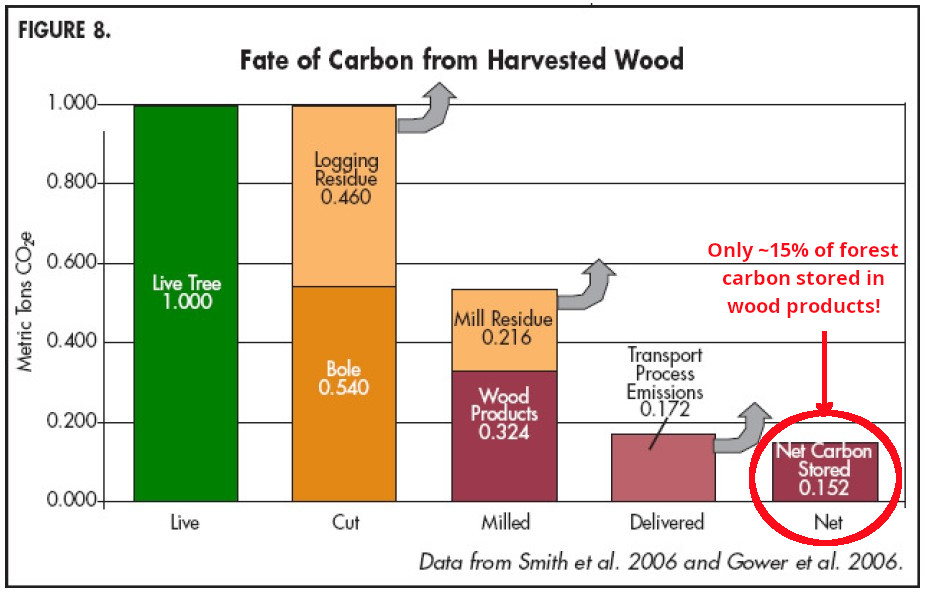
For each ton of forest carbon sequestered in wood products, roughly 13 tons are emitted to the atmosphere.
Draft Plan Echoes Industry Propaganda re: Carbon Storage in Wood Products: OSU’s draft plan categorically states, “Every instance of substitution of wood for more carbon-intensive materials (particularly steel, concrete and aluminum) in the built environment reduces net carbon emissions to the atmosphere.” This claim defies both common sense and basic science.
The relative carbon impacts of substituting wood for steel, aluminum, and concrete depend on a number of complicated details. How much wood is used compared to the other materials? Are both designs/applications providing precisely equivalent functionality? Does the life-cycle analysis account for the relatively small amount of forest carbon that ends up in the final product? Does the comparison take into account the pervasive adverse impacts of herbicides (such as poisoning of watersheds, animals and people)? How about the increased risk and severity of wildfire caused by the conversion of native forests to even-aged plantations? How does one account for the catastrophic damage caused by wildfires which are exacerbated by a century of extractive forest management? What about end-of-life impacts? Both steel and aluminum are readily recycled, while there’s little reason to expect specially-designed mass timber panels to be recycled or reused.
The draft plan’s broad, unfounded assertions (favoring wood substitution) echo timber industry talking points and undermine its own integrity. This reflects poorly on both the planning team and College leaders.

This wood pellet plant in Burns Lake, BC, is part of a global biomass energy industry that is significantly more polluting than coal-fired power plants. OSU is actively promoting this polluting industry through its research initiatives and language in the draft plan for the McDonald-Dunn.
Draft Plan Promotes Biomass Energy to Mitigate Climate Change: The draft plan devotes a relatively modest amount of attention to the subject of climate change (a little over two pages of the 171-page plan). It suggests forestry’s impact to the planet can be addressed through:
“Mitigation, in which the forests themselves and resultant forest products are used to sequester carbon, forest biomass is used to provide renewable energy, and greenhouse gas emissions are avoided through complementary product substitution (wood for carbon intensive fossil fuel consumer goods) and resilient forest composition and structure.” [emphasis added]
The promotion of forest biomass as a renewable source of energy to offset forestry’s adverse impacts to our climate reveals a profound bias and lack of understanding of the basic science of biomass energy.
Biomass Energy – Dirtier than Coal: Using forest biomass to produce energy is enormously polluting, energy-intensive, and expensive. Biomass plants are significantly less efficient (~24%) compared to those using coal (33%) and natural gas (43%).9https://www.pfpi.net/carbon-emissions/ The combustion efficiency of biomass is far lower than coal, and biomass has a high moisture content.10https://www.pfpi.net/wp-content/uploads/2011/04/PFPI-biomass-carbon-accounting-overview_April.pdf These factors mean biomass energy facilities emit substantially more greenhouse gas emissions per unit of energy than either coal-fired or natural-gas power plants. The amount of energy it takes to collect and transport forest biomass renders the process economically infeasible without significant public funding or tax subsidies.
Biomass Industry Leads to Destruction of Older Forests: The biomass energy industry has also come under heavy criticism for contributing to the destruction of vast areas of native boreal forest, which contain some of our planet’s largest carbon stores11https://environmentalpaper.org/2021/04/the-cost-of-industrial-logging-in-canadas-boreal-forest/. A 2021 analysis found that biomass energy was a major driver contributing to the destruction of Canada’s boreal forest (one of the world’s largest intact forests).12https://www.nrdc.org/bio/courtenay-lewis/new-report-shows-toll-unsustainable-logging-boreal In the Southern US, the wood pellet industry has driven extensive logging of mature hardwood forests. Rather than relying on wood waste, the industry is increasingly consuming whole tree trunks. The biomass industry has degraded water quality, destroyed important wildlife habitat, and reduced carbon stocks in these older forests.13https://www.selc.org/news/new-study-confirms-harmful-impacts-of-biomass/
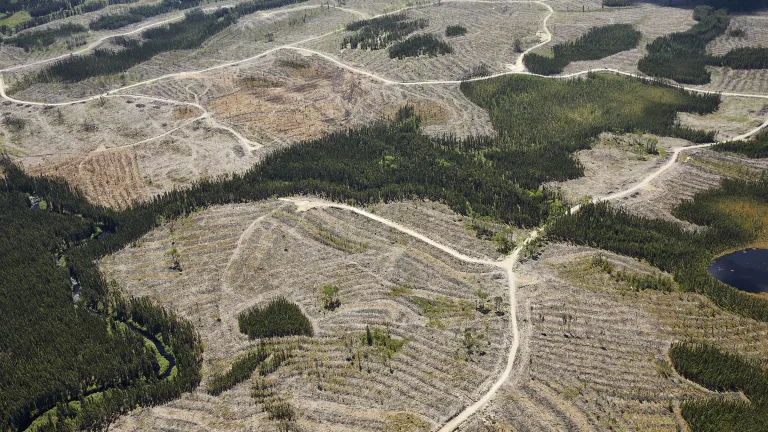
Vast swaths of old-growth boreal forest in northern Canada are being destroyed to produce the feedstock for biomass energy facilities. OSU’s draft plan promotes biomass energy by stating, “forest biomass is used to provide renewable energy, and greenhouse gas emissions are avoided through complementary product substitution” Our public university should NOT be promoting this polluting, destructive industry. (photo courtesy of River Jordan/NRDC)
Why is OSU Promoting Biomass Energy?: OSU is a regional anchor for the federally-funded Sun Grant Initiative, which supports research and development of biomass energy products (including vehicle fuels and feedstocks for electricity generation). The College of Forestry is also currently involved in projects to develop low-carbon fuels from woody biomass residues, in accordance with Oregon House Bill 3409, Section 30. 16 While this research includes life cycle carbon analysis, financial feasibility, and environmental impact assessments, OSU’s long history of timber industry collusion raises serious concerns about research independence. With the College awash in industry money, we can fully expect its “Clean Fuels Project” to help pave the way for an expanded biomass energy industry – regardless of the impact on our planet.
In summary, OSU’s latest attempt at forest planning reveals an institution that is deeply compromised by its timber-industry funding and roots. Rather than developing a forward-looking plan that incorporates the best available science and commits to long overdue changes in the management of public forests, the planning team has chosen to perpetuate the destructive practices of industrial forestry under the guise of research. The draft plan lacks basic, measurable constraints that are clearly justified given OSU’s long history of timber industry collusion. It is full of aspirations while notably lacking in enforceable commitments. Rather than promoting ecological forestry and honoring community values, the draft plan promotes an antiquated, extractive model of forest management. This plan reflects poorly on the College of Forestry, and will only further diminish public trust in our university.
* The value of the McDonald-Dunn Forests alone is roughly $150M based on prevailing timberland sale prices in western Oregon14https://blogs.oregonstate.edu/appliedeconomics/2025/05/15/recent-trends-in-the-price-of-oregons-timberland/. A timberland donation valued at $23.8M that was given to OSU in the early 90’s would be worth more than $50M today. The university received roughly $50M in industry-related donations to help cover the cost of the College’s Forest Science Complex. The College of Forestry lists 18 endowed faculty positions, and most of these are funded by timber industry donors.
